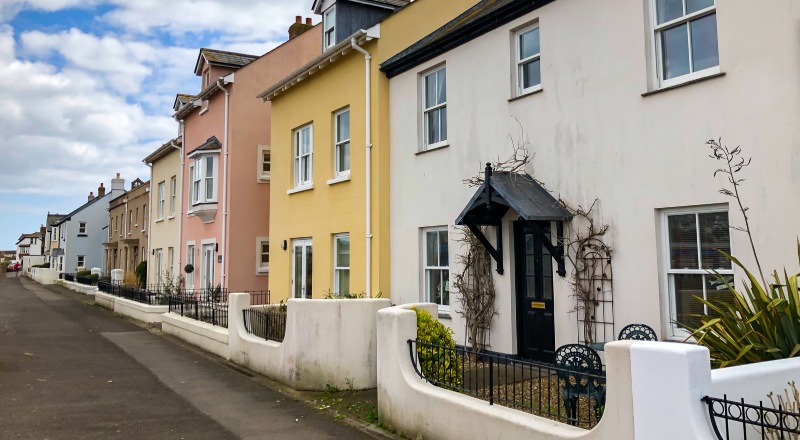Single skin, or single brick, properties are built with solid external walls and are most commonly found in Victorian houses.
There’s also a considerable number of extensions that have single brick walls.
While these properties have stood for over 100 years, there is some caution among certain mortgage lenders, who’s preference is the modern cavity wall.
But with over 8m houses in the UK with solid walls, there’s plenty of homeowners who still need suitable mortgages and remortgages.
How easy is it to get a mortgage?
Mortgage options are available. But it won’t always be a straightforward process.
Single skin wall, or single brick, properties are usually classified by lenders as ‘non-standard’.
Getting a mortgage on a non-standard construction means that:
- There are fewer lenders to choose from
- The lenders need lots of extra information
This is a classic example of where a mortgage broker can save loads of time.
You won’t be able to find a lender that accepts single brick construction on a mortgage comparison site. It doesn’t include that level of detail.
Also, a lot of lenders will accept them, but it’s not completely obvious that they do.

Step in Mr (or Mrs) Mortgage Broker.
An experienced mortgage broker will quickly get to the bottom of what type of lender you need. And then proceed to single them out before choosing the few that are most suitable for you, and your property.
What is a single brick wall?
Since around the 1930’s, houses in the UK have been built using the cavity wall system, for external walls. This remains the ‘standard’ method of construction and they are more energy-efficient than solid walls.
Cavity walls require two separate brick, or block walls, with a gap in between (the cavity). The outer skin is usually made of brick and the inner layer of brick or block.
Prior to this it was common to build with a single, solid wall, without the gap. The single skin method of building was very popular in Victorian times, especially with Victorian terraced houses.
Solid wall
Solid walls, made from a single layer of bricks or stone, are a traditional construction method offering strength, durability, and a traditional aesthetic.
They are less thermally efficient compared to cavity walls, leading to higher energy bills even with additional insulation. They are also more prone to dampness without preventative treatments.
While construction costs may be lower initially, maintenance may be higher due to potential damp issues and insulation needs.
Cavity wall
Cavity walls consist of two separate walls with a gap in between, enhancing thermal efficiency and damp prevention.
They are constructed using an outer leaf of brick, an inner leaf of concrete blocks, and are held together by metal or plastic ties. The cavity can be filled with insulating materials like foam or mineral wool to reduce heat loss.
Cavity walls require less maintenance, are more energy-efficient compared to solid walls, and are more acceptable to mortgage lenders.
Housing Stock
The housing stock in Great Britain (GB) is made up of different types of properties, for example cavity wall and solid wall properties.
At the end December 2017 there were:
28.1 million properties in GB
19.6m of these have cavity walls
8.5m of these have solid walls
Source: www.gov.uk – Household Energy Efficiency National Statistics, detailed report 2017
Why is it more difficult getting these mortgages?
Being approved for a mortgage is not just about showing that you can afford the repayments and having the right amount of deposit.
Although these are vital for a successful application, the lender also needs to be happy with the style and condition of the property you wish to buy.
And a big part of this is how it is constructed.
When a mortgage lender is assessing the property it is asking two main questions:
- Is the property habitable and worth the money?
- How easy is it to resell after repossession?

A single skin wall is no longer the approved method of construction.
Cavity walls have been the standard since the 1930’s, with subsequent improvements made to the insulation and building materials used.
So many lenders will put properties that have solid walls in to the ‘non-standard construction‘ category.
This means that they will either not bother with them at all, or that they will rely on their surveyor inspecting the property and then making a recommendation.
This can initially result in a ‘maybe’ response when asked if they lend on single skin wall houses.
There are three main issues associated with a single skin house:
Insulation
Single-skin houses are less thermally efficient compared to cavity walls, which leads to higher energy bills for the occupants.
Lenders may be concerned about the long-term cost-effectiveness and the property’s energy performance rating, which could affect its valuation and the borrower’s ability to manage energy costs alongside mortgage repayments.
Damp
Solid walls are more susceptible to moisture penetration and dampness, which can lead to structural or aesthetic damage over time.
The costs associated with treating or preventing dampness could be substantial, and there’s a risk of decreased property value if damp issues are left unaddressed. This poses a risk to the lender as the property serves as security for the mortgage loan.
Maintenance
Single-skin houses may require more frequent maintenance and repairs due to the issues with dampness and thermal efficiency.
The potentially higher upkeep costs could strain the borrower’s finances, possibly affecting their ability to keep up with mortgage repayments. Moreover, the need for repairs could also lead to a decrease in property value, which is undesirable from a lender’s perspective.
New builds
If you are buying a new build property then there’s no need to worry about single skin walls.
New builds must adhere to modern building regulations, ensuring a specific level of structural integrity and safety, this prevents single skin walls being used. They incorporate modern insulation and efficient heating systems for better energy efficiency, which can result in lower utility bills.

The lender’s surveyor
When a lender asks a surveyor to inspect a property they will be assessing the property against what the lender wants or prefers.
For example, some lenders are OK lending on PRC concrete houses or those that have a steel frame, others are not. Each has their own list of requirements.
Occasionally, a lender will defer to the professional opinion of their surveyor, based on their actual inspection of a property.
This is often the case with a property that has some degree of single skin construction. After visiting the property the valuer may request a more thorough structural survey before a final decision can be made.
This method allows for a more common sense approach to assessing single brick walls, as it can take in to account the overall condition of the property, any subsequent improvements and insulation, and its location.
Are there advantages to a single skin wall?
Buildings made with a solid wall have several drawbacks, including the risk of damp and poor energy efficiency.
However, single skin walls are simpler and potentially quicker to build, which lead to a lower cost of construction.
One big advantage is that the wall itself does not require any ties within the wall, as the wall is solid and without gaps.
Wall ties help hold the two layers of a cavity wall together, but they can have some issues.
They can rust over time, especially in wet or salty areas, which can weaken the wall. Metal ties can also let heat pass through, making the house less energy-efficient, although newer ties are designed to prevent this.
If not installed correctly, they can fail to provide enough support to the wall. There can also be issues if the ties and the mortar don’t work well together. Fixing any problems with wall ties can be expensive and a hassle.

What about single skin extensions?
Extensions built with solid walls, without a cavity, are widespread. Getting a mortgage on a house with a single skin extension is much easier if the rest of the property is built with cavity walls.
Some lenders are OK if the single skin is part of a one storey extension, a few will consider extensions up to two storeys high.
If you are planning to build an extension to your home then you should think very carefully about how the walls will be constructed. This could affect your ability to apply for a capital raising remortgage, or its future saleability.
WhAT THE lenders SAY ABOUT this style of property
Unacceptable Properties
Single brick (single skin) construction
Other unacceptable properties
Single skin properties (extensions are acceptable up to 20% of the total area
of the property).
Single skin/ half brick thick walls
Single skin/half brick thick walls are only acceptable in older properties where the walls are within single storey structures and contain non-habitable rooms.
Any single skin wall structure above single storey is normally unacceptable.
Single Skin
Not accepted.
Unacceptable Property/Construction Types
Single skin construction is only acceptable for an extension at ground floor level.
Single Skin Construction
The Society will only allow a small portion of the property to be constructed of single skin which must only be one storey in height and subject to satisfactory comments from the valuer.
Construction of brickwork
Single skin brickwork is only acceptable for garages and porches provided they are single storey, or a small proportion of the habitable area subject to valuer’s guidance.
A property of standard construction will typically meet the following criteria and are appropriate for mortgage lending
Walls – Solid (min 230mm) or cavity (min 280mm), built in brick, natural stone, reconstituted stone, concrete block, cob or flint.
Other eligibility factors
If you choose to buy a house which has at least one solid external wall then it’s likely to be classified as a non-standard property by mortgage lenders.
Because of this, it is vital that you are able to meet the other eligibility criteria.
The main criteria are:
DEPOSIT – The larger the deposit you can save, the better options you have. Some lenders will decrease their LTV for non-standard properties, meaning you need to come up with the balance in the form of a larger deposit.
AFFORDABILITY – As well as your regular income, any lender will want to check that you can afford the new mortgage repayments. This involves analysing what you spend your money on, and how.
CREDIT STATUS – Having a good credit history will increase your chances of a successful application. Options are available even if you have some bad credit.
AGE – If you are getting a mortgage later in life then you need to be aware of a lenders maximum age criteria. Some lenders are more flexible than others, and it’s even possible to find a mortgage if you are a pensioner.

How a mortgage broker can help
Getting a mortgage for a property with a solid wall is not always straightforward.
As single brick mortgages are non-standard, many high street lenders won’t offer them and those that will accept them could charge higher interest rates.
An independent mortgage broker will have access to the whole mortgage market, over 100 lenders. These include the well known high street banks, building societies and specialist lenders. Many of these only deal with brokers and intermediaries.
Using a broker not only saves you loads of time, you also get access to exclusive ‘broker only’ deals and professional advice on how best to set your mortgage up.
Ready to explore your options?
If you’re just about to start your mortgage journey and could use the guiding hand of a professional, don’t hesitate to reach out to a reputable mortgage broker.
An independent mortgage broker can access over 100 lenders on your behalf. They will make the process smoother and more profitable than going it alone.
Keep reading, keep asking questions. The more you know, the better decisions you can make.


